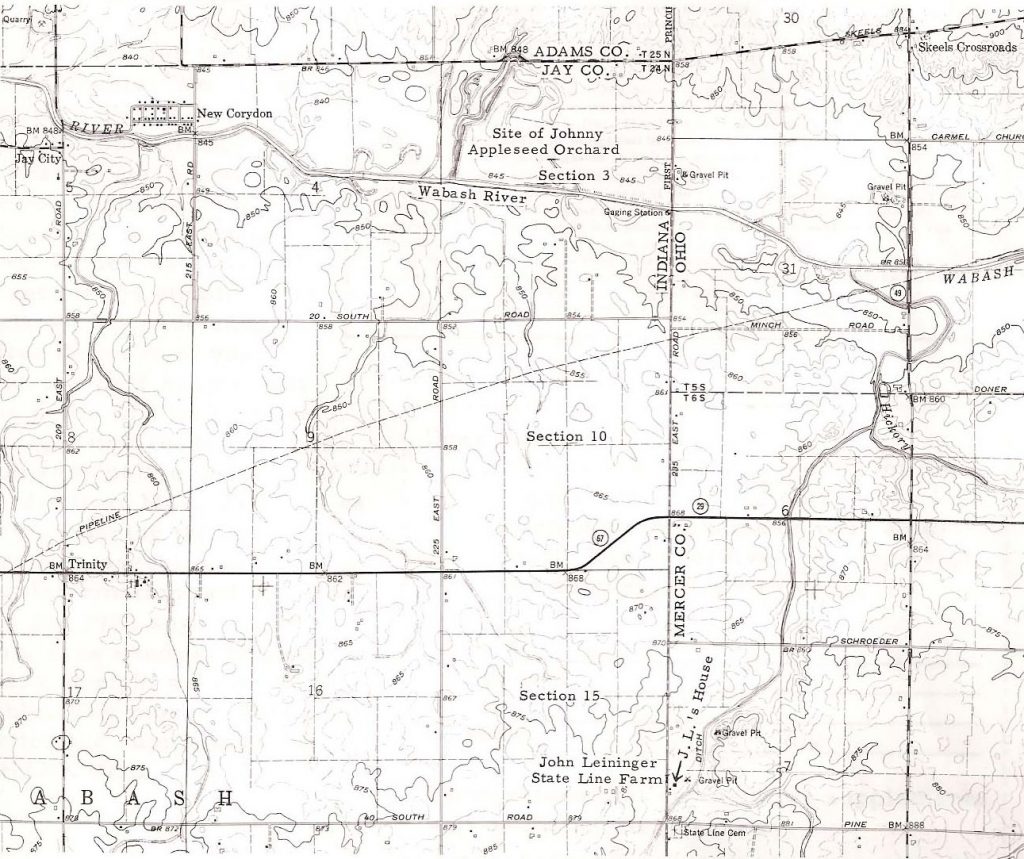
What a busy week it’s been for me! The Association of Professional Genealogists conference is wrapping up today. It was wonderful – timely topics, fun networking events, and it was great to see colleagues again. I highly recommend you attend next year if you are contemplating going Pro.
Today, however, I want to focus on an item I finally crossed off my bucket list. Last Sunday, I attended the Johnny Appleseed Festival in Fort Wayne, Indiana. It was on my to-attend list since I first learned about it years ago.
I fell in love with John Chapman, aka Johnny Appleseed, when my mom read me a library book about him when I was in pre-school. I don’t recall the title but I do recall one of the pictures. Granted, I now know the information wasn’t 100% factual but it did make a major impression on my young mind. I can still picture the book page depicting him in blue pants with ripped hems, suspenders, scraggly brown hair, tall and thin with forest animals following him as he threw apple seeds from a beige bag slung across his body.
I wanted to be him! How cool to be able to walk barefoot, plant seeds, and have all the animals be your friend!
Fast forward to 1985 when my father gave me a necklace that belonged to my grandmother and an old toolbox he had inherited from his father. He wanted me to pass them along to my children someday. Inside the toolbox were newspaper clippings, undated and the paper unknown, mentioning a reunion for relatives of Johnny. Unfortunately, since I’m still unpacking, I can’t put my hands on it and I could have sworn I scanned it but I can’t locate that, either. Sigh.
The clipping intrigued me. Why would my father have saved it? Was he as enamored with Johnny as I was? I wasn’t close to my father so I had no idea. I should have asked but I didn’t.
In the late 1990s, after my father’s death, I linked up with a Leininger researcher who kindly sent me an electronic copy of two books he had written in the 1970s about the family. That’s where I discovered that Johnny was connected to me through marriage. The map above shows the location of Johnny’s farm.
My “relationship” with Johnny is through my paternal line. Although Johnny had no children, and it’s in dispute whether he had ever married or not, he was close to one of his siblings, sister Percis (1793-1859), who had married William Broom (1792-1848). Percis and William’s daughter, Elizabeth (1829-1863) married John George Leininger (1826-1917). John George is my 2nd great uncle, brother of my 2nd great grandfather Theabald (1824-1900).
Genetically, I’m not related to Johnny. When Johnny was in the area, he stayed with Percis, as Elizabeth fondly recalled as an adult. In his older years, he visited Elizabeth and her family, as her children remembered.
I always wanted to grow an apple tree but Florida is the only state where apple trees won’t grow. I tried, however! I once brought back seeds from a wild apple tree growing in a Pennsylvania cemetery where my husband’s Harbaughs were buried. A cemetery caretaker claimed the tree was the remnants of one of Johnny’s orchards which he had scattered throughout the then wilderness. I did get the seeds to sprout by placing them in a wet paper towel, inserted into a baggy, and kept in the fridge. As soon as I planted them in the dirt in a Solo cup, however, they shriveled and died. Now that I’m in Indiana I will definitely plant that tree! I won’t be using one of Johnny’s, though, as his trees produced fruit best for hard cider which was medicinal for the pioneers. I’m leaning towards Albermarle-pippin, a favorite of Ben Franklin, Queen Victoria, George Washington, and Thomas Jefferson. I plan on visiting a local orchard this week to get details on when I should be planting. A neighbor told me it’s best to plant fruit trees here in months that end in “R.” I love hearing these old ways to successfully garden. So much of that knowledge has been lost. I wish there were a book about farmer wisdom from days gone by.
But back to the festival – It was a beautiful warm late summer day in Archer Park, on the bank of the St. Joe River. It is the final resting place of Johnny who is buried on the top of a hill. So many vendors were selling homemade craft items, antiques, produce, and food typical of pioneer life. My hubby said this was his favorite festival he ever attended. Since much of the food was made on site, the smell of the campfires filled the air. Craftspeople demonstrated their skills in metalworking, sewing, photography, etc. They were so knowledgeable and I learned so much.
My favorite part was the cannon salute that opened the day. It was in commemoration of the opening of the Wabash and Erie Canal in 1832. Theabald and John George, along with their parents and some siblings, emigrated from Alsace-Lorraine to Ohio in 1827 via a canal to Canton, Ohio. That was likely the Ohio and Erie Canal. It reminded me of how important water travel was back in the day.
History, genealogy, and the festival were intertwined for me which made it so memorable.
October is around the corner and I’ll be writing my annual coincidence blogs. I’ve had some really weird things happen in the past few months that I’ll be sharing. See you next weekend!





